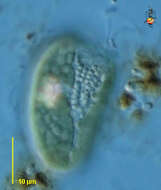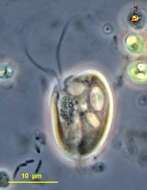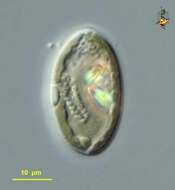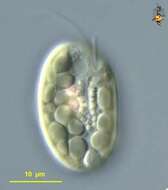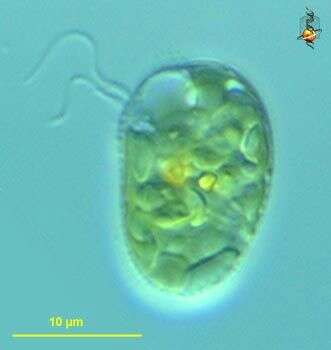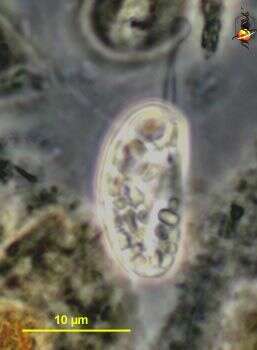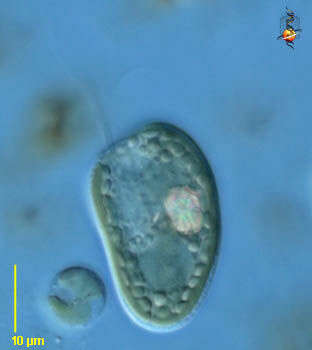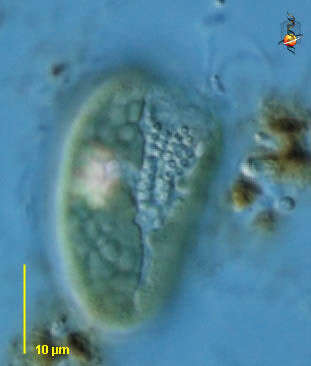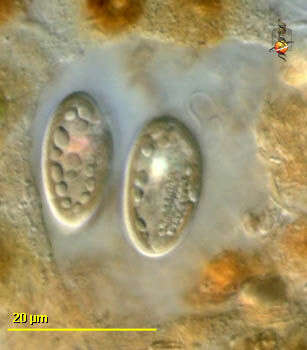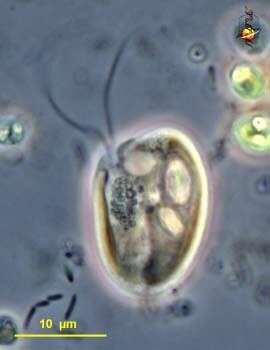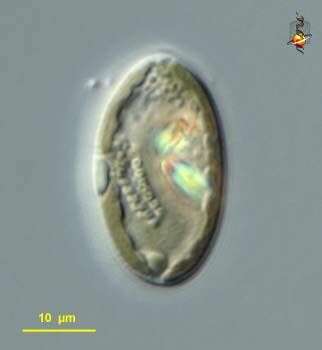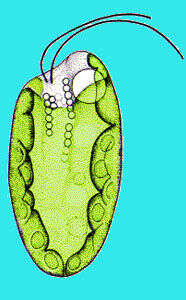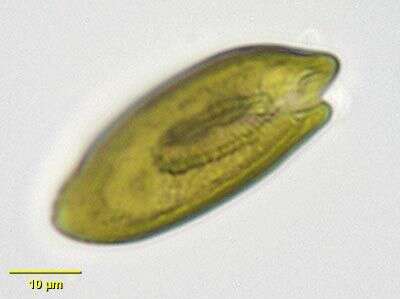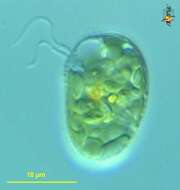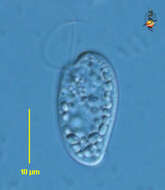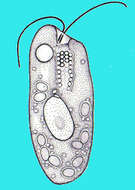-
Campylomonas (cam-pile-owe-moan-ass) one of the cryptomonad flagellates with olive-green plastids. The inclusions are mostly polysaccharide storage. Two flagella visible at top (anterior) and surface is irregular because of the small skeletal plates that lie under the cell membrane. Differential interference microscopy.
data on this strain.
-
Chilomonas (kai-low-moan-ass), one of the two genera of cryptomonad flagellates which do not have chloroplasts. There are two flagella which insert into a groove which opens subapically (the dent near the front of the cell is where is opens). Cytoplasm with large numbers of polysaccharide granules. Differential Interference Contrast.
-
Chilomonas (kai-low-moan-ass), one of the two genera of cryptomonad flagellates which do not have chloroplasts. There are two flagella which insert into a groove which opens subapically (the dent near the front of the cell is where is opens). Special extrusomes (ejectisomes) form a little cluster around the flagellar pocket (the pocket can not be seen). Cytoplasm with large numbers of polysaccharide granules. This cell slightly distorted. Differential Interference Contrast.
-
Chilomonas (kai-low-moan-ass), one of the two genera of cryptomonad flagellates which do not have chloroplasts. There are two flagella which insert into a groove which opens subapically - the flagella can be seen here as the two dark filaments emerging from the anterior (top) of the cell. Cytoplasm with large numbers of polysaccharide granules. Phase contrast.
-
-
Chilomonas paramecium Ehrenberg, 1831. Colourless cryptomonads, with stiff elongate-ovate body, 19 to 30 microns long. Two subequal flagella, shorter than the length of the body, insert in an anterior pocket which is surrounded by rows of extrusomes. Small extrusomes are also visible under the cell membrane. The nucleus is located posteriorly to the pocket. A contractile vacuole is located anteriorly and empties into the pocket. Cells contain refractile storage products and often two refractile Maupas bodies. Cells rotate while swimming, and can also swim backwards.
-
Cryptomonas (crypt-oh-moan-ass), a common genus of cryptomonad flagellates with chloroplasts. There are two flagella which insert into a groove which opens subapically (the dent near the front of the cell is where is opens). The flagella can be seen upper left. Special extrusomes (ejectisomes) form a little cluster around the flagellar pocket (the pocket can not be seen). Off green chloroplasts, and the orange pink item to the right side is a crystalline inclusion encountered in many cryptomonads. With numerous small polysaccharide inclusions. Differential Interference Contrast.
-
Cryptomonas (crypt-oh-moan-ass), a common genus of cryptomonad flagellates with chloroplasts. There are two flagella which insert into a groove which opens subapically (the dent near the front of the cell is where is opens). The flagella can be seen upper right. Special extrusomes (ejectisomes) form a little cluster around the flagellar pocket (the pocket can not be seen). Two off green chloroplasts, and the orange pink item to the left side is a crystalline inclusion encountered in many cryptomonads. Differential Interference Contrast.
-
Cryptomonas (crypt-oh-moan-ass), a common genus of cryptomonad flagellates with chloroplasts. Special extrusomes (ejectisomes) form a little cluster around the flagellar pocket (the pocket can not be seen). Two off green chloroplasts, and the orange pink item is a crystalline inclusion encountered in many cryptomonads. With numerous small polysaccharide inclusions. Differential Interference Contrast.
-
Cryptomonas (crypt-oh-moan-ass), a common genus of cryptomonad flagellates with chloroplasts. There are two flagella which insert into a groove which opens subapically. Special extrusomes (ejectisomes) form a little cluster around the flagellar pocket . Off green chloroplasts, and the orange pink items are crystalline inclusions encountered in many cryptomonads. With numerous small polysaccharide inclusions. Phase contrast.
-
Cryptomonas (crypt-oh-moan-ass), a common genus of cryptomonad flagellates with chloroplasts. There are two flagella which insert into a groove which opens subapically. Flagella not visible here in this image which emphasises the extrusomes (ejectisomes) that form a little cluster around the flagellar pocket . Off green chloroplasts, and the orange pink items are crystalline inclusions encountered in many cryptomonads. Differential interference contrast.
-
Cryptomonas (crypt-oh-moan-ass), a common genus of cryptomonad flagellates with off green chloroplasts, and the orange pink item out of focus is a crystalline inclusion encountered in many cryptomonads. With numerous small polysaccharide inclusions. Differential interference contrast.
-
-
Cryptomonas, a common cryptomonad flagellate. Prominent extrusomes are seen lining an invaginated canal anteriorly. Two flagella (not well seen in this image) emerge from the canal. The nucleus is seen just posterior to the linear array of extrusomes. This is a relatively large species approximately 45 microns long. From freshwater pond near Boise, Idaho. Brightfield illumination.


